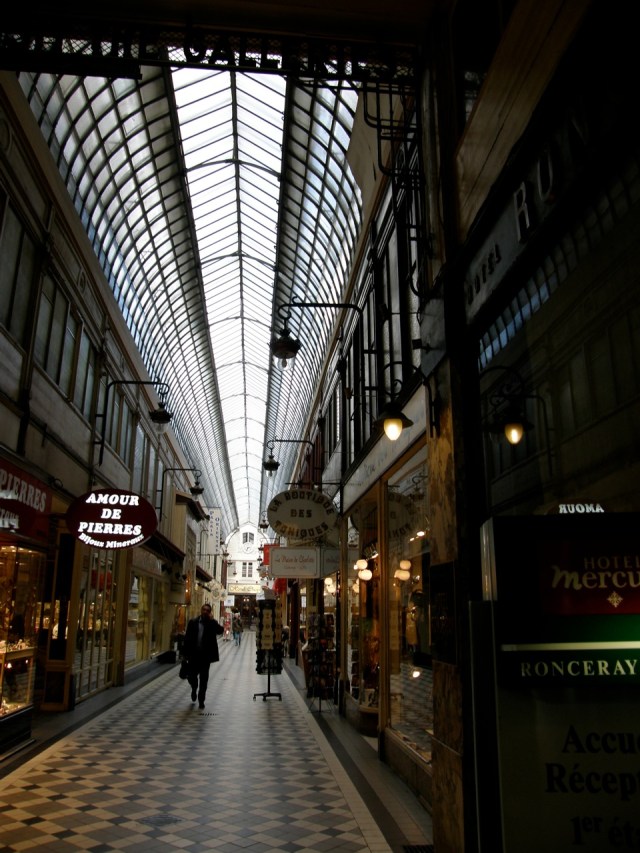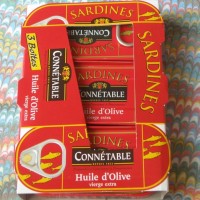Last week we showed a picture of a bridge, which was on my list of must-sees in Paris. And I wondered how many of those who flock to the Eiffel Tower also visit the 1867 suspension bridge over the artificial lake in the Parc des Buttes Chaumont. The connection? They were both designed by Gustave Eiffel.
The suspension bridge is as stunning as the 19th century park around it. For those who think of French parks in terms of flat terrain and formally laid out flowerbeds in which mathematical precision dominates nature, the Parc des Buttes Chaumont will be an eye-opener. It opened in 1867, the same year as the Universal Exposition. The park was created on the site of a former quarry that had degenerated into a slum.
However, unlike, say, the Tuileries, which had also been an industrial site (a tile works), the Parc des Buttes Chaumont makes the most of its past as a quarry. With its artificial lake, stalactite-filled cave, waterfalls, brooks, bridges, and changes in elevation, Buttes Chaumont seems more English or Chinese than French. Perhaps its crowning glory is the Belvedere, an architectural feature designed to make the most of a good view. How different the park would have been had this tall outcropping been levelled.
One of the paradoxes of Paris is that is it so densely populated and so green. Although the legacy of Napoleon III and Baron Haussmann is sometimes criticized, we can thank these two for many of the city’s loveliest parks. During the 17-year reign of Napoleon III, the city added 4,950 acres of woods, parks and gardens and planted 600,000 trees. Buttes Chaumont, the steepest and third-largest of Paris’s parks was one of those created in this period.
The suspension bridge in the park was the work of a relatively unknown young engineer making his first imprint on the city. Twenty-two years later, the same engineer had become famous for his elegant and daring long-span bridges. Across the River from the Champ-de-Mars, he erected Paris’s most famous monument for the 1889 Exposition: the Eiffel Tower.
Philippa and I visited the park a few years ago on a warm spring afternoon. We marvelled at the suspension bridge, admired the view from the belvedere, and lamented the fact that we had to leave too soon. We will be back in a few months with a picnic lunch and more time to enjoy the view. It is one of the world’s “Great Public Spaces… the places we remember most vividly, the places where serendipitous things happen, the places we tell stories about.”
But there is more to my interest than just the view and the connection with the famous Gustave Eiffel. I am a historian of technology and design, and when I find myself looking at old postcards, my eye is often caught by interesting technology.
For me, a Paris postcard can be anything you find in Paris. It doesn’t have to be about Paris. The next images are among my most treasured Paris postcards. I bought them there, but they are of unusual river crossings in Rouen and Nantes, two cities I have never visited.
It seems a peculiar way to cross the water. And the translation of the text on these postcards isn’t a lot of help. La nacelle can mean the basket under a hot-air balloon or a type of small boat. And le pont transbordeur is a transporter bridge.
The next photograph should make things a bit clearer.
The two tall towers (70 metres high) are joined by what looks like an elevated roadway. That roadway or deck is 142 metres long, and under it is a movable overhead electric crane. Cables drop 50 metres from the crane to the suspended nacelle. You can just see the nacelle here, skimming above the water. In the picture, the cables are not visible, but you can see the shadow under the nacelle.
Pure genius. How to get goods, vehicles and people across a busy waterway without interfering with the clearance needed for tall-masted ships in the age of sail? Clearly one needs a tall bridge. But instead of having the extremely long approach roadways that a conventional bridge of such height would demand, Ferdinand Amondin (1845-1924) used the elevated deck roadway to carry a moving electric-powered crane that would support what was essentially a section of bridge at ground level, lift it as needed and then move it across the river and dock it on the other side.
Pedestrians could walk onto one of the two outside passenger sections, and drivers went onto the centre portion of the nacelle and waited to be transported across the river to dock on the other side.
Amondin made other bridges besides those at Rouen (1899) and Nantes (1903). I have spent some time finding out more about him and them. And for all the fun I have had learning about him and his bridges, I have to thank a serendipitous encounter with postcards at a flea market in Paris.
If I have whetted your appetite for Paris postcards, here is where you can find out some more about them, and where you can buy them for yourself.
The best source of information I know is the book by Leonard Pitt, Paris Postcards: The Golden Age (2009). I also highly recommend Pitt’s informative website.
Pitt, an American who has lived in France, draws on his own superb collection and knowledge to produce a book that begins when postcards were just being made legal and “created the first form of social networking equivalent to today’s e-mail.” And yes, there were concerns that “this new type of message, shorter than the traditional letter, meant that people would forget how to write” (where have we heard this before?). But the public embraced the new form of communication and by the early 1900s, most families had postcard albums.
Where to find them?
Flea markets are a good place to start. My favourite is the Porte de Vanves. Note that the more they have been picked over and presorted for you by the vendor, the more you can expect to pay.
The Marché aux Timbres et aux Cartes téléphoniques (Postage Stamp and Telephone Card Market) is another rich source of postcards. I found about this one through Dixon and Ruthanne Long, Markets of Paris (New York: The Little Bookroom, 2006). It is held Thursdays, Saturdays and Sundays in a Park on the Avenue de Marigny from Avenue Gabriel to Allée Marcel Proust in the 8th arrondissement. Philippa has reminded me that this market features in one of her favourite Audrey Hepburn films: Charade.
Go on a nice day, as the market is outside. Some dealers have things well organized by arrondissement for Paris and numbered regions for the rest of France. Others organize by subject matter such as bridges, animals, special occasions, or humour. And others just have bins of postcards for you to sort though on your own. The more you are willing to rummage through yourself, the more likely you are to find something that speaks to you at a price you are willing to pay.
You can also find postcards in several of Paris’s surviving 19th-century shopping arcades (passages couverts), or covered shopping areas.
Passage des Panoramas in the 2nd arrondissement is a traditional philatelic centre, so head there. At Maréchal you will be treated to a wide range of stock in varying price ranges. As in many French stores, the staff have an astounding range of subject knowledge and know their stock well. Don’t be afraid to ask questions, even if your French ranges from the terrible to the non-existent. They are also set up to cater to a wide range of interests, knowledge, and budgets. Several years ago I found some fine Canadian cards relating to a project I was working on, set out on a table in front of the store where all of the cards were one Euro each.
When you’ve finished in the Passage des Panoramas, cross Boulevard Montmartre to Passage Jouffroy, another historic arcade. We always stop in at numbers 39 and 48, the two storefronts of Librairie du Passage, which carries a wide range of books, many beautifully illustrated, often at remarkably low prices.
Where else? Throughout Paris you will find dozens of small shops that sell old objects, some of which are antiques and some of which are just old bric-à-brac: art works—some torn, some stained, some intact—glass, porcelain, jewellery, magazines, books, battered suitcases, walking sticks, you name it, as well as postcards.
Trust me on this: if after you enter, you say “Bonjour, monsieur / Bonjour, madame,” pause, and then ask, “Avez-vous des cartes postales?” they will materialize. Last December I found some unusual postcards at 1 Euro each in a shop in Montparnasse, in an area filled with art supply stores. You just never know.
Postcards are everywhere. Have fun. Tell me about your favourites.
Text and photographs by Norman Ball.
P.S. We are not in Paris right now, but if we were, we’d follow up on some of the Valentine’s Day rendezvous suggestions listed on Paris Weekends, a creation of Adam Roberts, who writes one of our favourite blogs: Invisible Paris. Adam, who has a genius for finding and finding out about overlooked corners of the city, asked for contributions from other bloggers, and we were thrilled to be included. To see what we chose, click here.





























Always look forward to the Friday, Paris, feel good factor. Thank you, one and both, for sustaining us all through the dark winter months. Paris beckons at any time of year but when the rain is incessant and the ceilng is only a few thousand feet, it’s wonderful to be transported to another world every Friday.
Pingback: The Paris Blog: Paris, France Expat Tips & Resources »Blog Archive » Whither Gambetta?
Magnifique! This posting has united more of my obsessions than any other – Parc des Buttes-Chaumont, vintage postcards, passages couverts, transporter bridges. These are themes I’ve been rambling on about for the last 4 years on my blog – it’s a joy to discover I’m not alone. The Eiffel bridge at PB-C has recently been restored after many years of closure and is well worth a visit. And the Petite Ceinture runs through the hallowed precincts. Thanks for the tip re Leonard Pitt’s book. I can recommend the Wednesday marché at Saint-Mandé for postcards.
Thanks for your comment and your enthusiasm. We have added a link to your own very informative and interesting blog. If you like vintage postcards, watch for more posts on this subject in the coming weeks. And now we know where we will spend Wednesdays in Paris on our next visit!
Could you direct me to the posts you mention here “in the coming weeks” about vintage postcards? I did a google search “where to find old postcards in Paris” or something to that effect and one of the hits was your website. I belong to the San Francisco Bay Area Postcard Club and collect a wide variety of postcards. My special interest is artist-signed cards by various artists, especially of fairies, children and just about anything that catches my eye. A recent “re-purchase” (I had it, sold it, bought another) is by artist A.M. Cassandre of an art deco design of a poisson, a shell and the black silhouette of a lobster on a white tablecloth on a table. It is an advertisement on the reverse for Maison Prunier at 9, Rue Duphot, 16, Av. Victor-Hugo in Paris and “Meme Maison” a Londres at 72 St. Jame’s Street. Anyway, I am coming to Paris in late Sept. and have found several locations to visit, including a market outside the 20th arrondisement. I was wondering if you had a “best place” to begin of the several I have found. They include Clignancourt(sp?) and a Stamp shop near the Champs Elysee. I also have a member of the club to get more assistance on this topic, but I just thought I would connect with you here. Thank you.
Pingback: Tall tales and some Paris-Marseille rivalry | Parisian Fields
Pingback: On reaching 100 – blogs, that is | Parisian Fields
Pingback: Where to Buy: Paris Postcard Shopping Tour | Max & Co. Post
Hi…We are off to Paris on Monday so i began researching places to go and came to your wonderfull blog…thank you…to my surprise there was a french image of our Transporter Bridge or so i thought…here is a link to it on Wikipedia with some interesting facts..will defo go to the park and visit eiffels other engineering feat…cheers…Jed Stonehouse from North East England
Dear Jed,
Thank you for your comment. Would that be the Tees/Middlesbrough transporter bridge?
If you are a hard-core Eiffel fan, you might be interested in his wind tunnel, which is in the 16th arrondissement. Here is a link: http://www.aerodynamiqueeiffel.fr We visited it on our recent trip to Paris. It is still in use.
Norman and Philippa
hi yes thats tees/middlesbrough…merci for the wind tunnel tip…au voir..jed